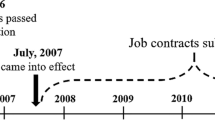Abstract
In Sweden, the new government that took office in 2006 gave the Public Employment Service instructions to introduce private contractors as a complement to publicly provided services. In this paper I use survival analysis in an intention-to-treat approach to compare time to employment of jobseekers in labor market areas that cooperated with private contractors with jobseekers in labor market areas that did not cooperate with private contractors, all within the program Job and Development Guarantee. I use register data from the Swedish Public Employment Service and exploit within region and period variation in a differences-in-differences approach. I find that the labor market areas that cooperated with private contractors had lower turnover to employment than labor market areas that did not cooperate with private contractors. The observed result could be due to different reasons. However, among other things, the contract agreement with private contractors was not optimally designed with a poor incentives structure. Moreover, the introduction of private contractors increased the administrative burden upon the staff of the Public Employment Service.
Similar content being viewed by others
Notes
Contracting out public employment services has been done to some extent in Denmark, Germany and Britain. In Australia and the Netherlands the public option is more or less unavailable now.
A total of 15 areas were designated as employment zones in April 2000.
Jobb- och utvecklingsgarantin, RiR 2009:22
For a thorough description of the initial trial period, see Bennmarker et al. (2009)
Arbetsförmedlingen (2010).
January 2007 – March 2008
This is done by using the split command in stata.
A jobseeker is considered to be newly arrived if he or she has not been In Sweden more than 3 years.
Other known reasons are sick leave and early retirement.
Whether a retiree ends up in the category known reason or in the category unknown reason depends solely on whether they inform the Public Employment Service when they retire.
Variables used when matching is gender, whether disabled or not, level of education, age, whether you are newly arrived or not, whether you are Nordic citizen or not and you labor market history.
Here I treat each observation as a unique and single event; I employ the analysis for the matched and a non-matched sample for comparison.
References
Arbetsförmedlingen (2010) Arbetsmarknadsrapport 2010
Behaghel L, Crépon B, Gurgand M (2012) Private and Public Provision of Counseling to Job-Seekers: Evidence from a Large Controlled Experiment, IZA DP No. 6518
Bennmarker H, Grönqvist E, Öckert B (2009) Effects of outsourcing employment services: evidence from a randomized experiment, IFAU, WP 2009:23
Bernhard S, Wolff J (2008) Contracting out placement services in Germany. Is assignment to private providers effective for needy job-seekers? IAB Discussion Paper, 5/2008
Brutell O (2005) Are Employment Zones Successful? Evidence From the First Four Years, Local economy, vol. 20, No. 4, 389–403, November 2005
Hales J, Taylor R, Mandy W och M Miller (2003) Evaluation of Employment Zones: Report on a Cohort Survey of Long-Term Unemployed People in the Zones and a Matched Set of Comparison Areas, National Centre for Social Research, DWP Report 176
Hasluck C, Elias P, Green, A (2003) The Wider Labour Market Impact of Employment Zones, Warwick Institute for Employment Studies, DWP Report 175
Krug G, Stephan G (2011) Is contracting-out intensified placement services more effective than in-house production? Evidence from a randomized field experiment. LASER Discussion Papers, Paper No. 51
Prop. 2008/09:1, utgiftsområde 14 Arbetsmarknad och arbetsliv, bet. 2008/09:AU2, rskr. 2008/09:134–136 (till Finansdepartementet, Arbetsmarknadsdepartementet och Riksrevisionens styrelse)
Riksrevisionen (2009) Jobb- och utvecklingsgarantin. En garanti för jobb? RiR-rapport 2009:22
Shleifer A (1998) State versus private ownership. J Econ Perspect 12(4):133–150
Winterhager H (2006) Private Job Placement Services – A Microeconometric Evaluation for Germany, Discussion paper No. 06–026
Winterhager H, Heinze A, Spermann A (2006) Deregulating job placement in Europe: a microeconometric evaluation of an innovative voucher scheme in Germany. Labor Econ 13:505–517
Author information
Authors and Affiliations
Corresponding author
Additional information
The STATA software has been used and DO files can be delivered upon request.
The data used is register data from the Swedish Public Employment Service.
Appendix
Appendix
Rights and permissions
About this article
Cite this article
Sund, K. Did the Introduction of Private Contractors Improve Turnover to Employment in the Swedish Labor Market?. J Labor Res 36, 389–408 (2015). https://doi.org/10.1007/s12122-015-9211-2
Published:
Issue Date:
DOI: https://doi.org/10.1007/s12122-015-9211-2




